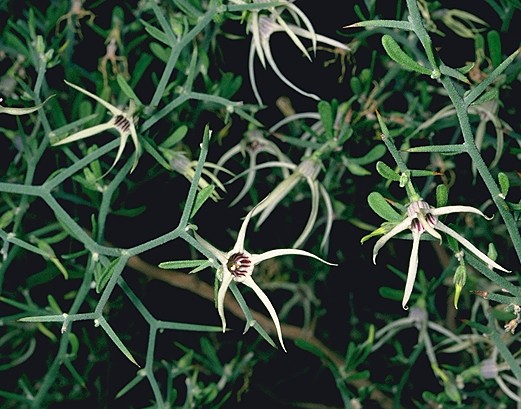
Synonymy
Anthocercis anisantha Endl. subsp. collina Haegi, Telopea 2: 174 (1981)
T: Yandinga Gorge, c. 50 km N of Minnipa, S.A., 15 Aug. 1969, A.E. Orchard 2171; holo: AD; iso: CANB, K, MO, PERTH.
Description
Spinescent shrub to 3 m, leafy to almost leafless, pubescent with predominantly non-glandular hairs, rarely mostly glandular or glabrous. [CHECK]
Leaves narrowly elliptic, ovate, obovate, sessile or almost so, mostly 3–14 mm long, 1–3 mm wide, entire, often thick and fleshy or leathery.
Flowers in cyme-like, compact, terminal clusters; pedicels 2–6 mm long. Calyx 2–4.5 mm long. Corolla 7–20 mm long, white to yellowish, the striations purple-brown or maroon; lobes linear to narrowly ovate, 2.5–15 mm long. Stamens 2–6 mm long.
Capsule ovoid to ovoid-ellipsoid, acute, acuminate or apiculate, 4.5–9 mm long. Seeds 1.3–2 mm long.
Distribution and ecology
Uncommon, endemic to the northern Eyre Peninsula, S.A.
Mostly occurs in Triodia hummock grassland on rhyolitic-porphyritic hills of the Gawler Ranges and on isolated hilltops further south.
Notes
Distinct from subsp. anisantha by the predominantly non-glandular rather than glandular indumentum on the branches.
Information on the midges which form galls in the fruits of this species can be found in Lepschi et al. (1999).
Reference: Lepschi, B.J., Kolesik, P. & Gates, M. (1999). Notes on the fruit gall fauna of Anthocercis anisantha (Solanaceae) in
Selected specimens
S.A.: c. 30 km SW of Kimba, L.Haegi 1309 (AD, MO, NSW, PERTH); Mt Wallaby, E.N.S. Jackson 2016 (AD, BRI); Mt Notts, D.E. Symon 8072 (ADW).
Derivation of epithet
From the Greek anison = unequal and anthos = flower
Images and information on web
A fact sheet for this species can be downloaded from the SA eFlora site.
Pharmacology:
A discussion of the tropane alkaloids which occur in Anthocercis and other Anthocercideae can be found in Griffith & Lin (2000).Ref: W.J. Griffin & G.D. Lin (2000). Chemotaxonomy and geographical distribution of tropane alkaloids. Phytochemistry 53: 627–628.
References to the possible toxic properties of Anthocercis species can be found with a search in the
FDA Poisonous Plant DatabasePlant status (if any)
Without any declared rating in S.A.


